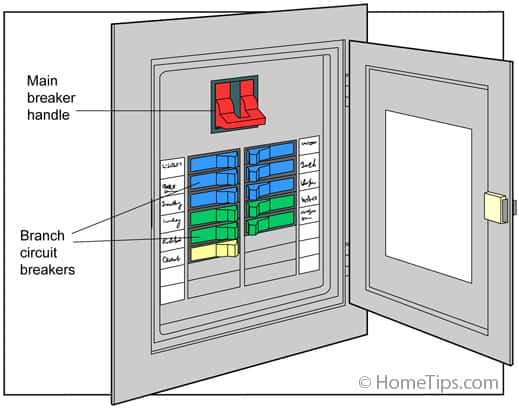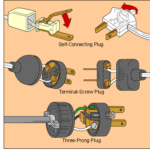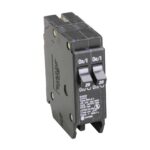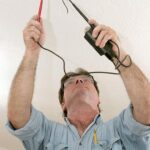Expert advice on how to find a circuit breaker that keeps tripping, either by manual testing for the tripped breaker or by using a circuit breaker finder tool
Picture this: you’re in the middle of watching your favorite TV show or preparing a delicious meal, when suddenly, the power goes out, leaving you in the dark. When you rush to the circuit breaker panel, you’re faced with a confusing array of switches (circuit breakers), none of which are properly labeled—so you don’t know which one to turn on.
Fear not! In this blog post, we’ll show you how to identify a tripped circuit breaker or, if the tripped breaker isn’t obvious, two methods to trace which breaker controls the circuit that’s off: 1) a manual approach or 2) tracing the problem with a circuit breaker finder tool.
What Is a Circuit Breaker?
First, let’s clarify what a circuit breaker does and how it works. A circuit breaker protects an electrical circuit from an electrical overload, a ground fault, or a short circuit, all of which can cause a shock, electrical fire, or damage to electrical equipment. Without getting too technical, let’ just say it’s basically a switch that flips off if the electricity flowing through the wires becomes unsafe. This usually happens when you’re overloading the circuit by having too many lights or appliances plugged in and a high-current appliance like an iron or a toaster gets turned on. (Some appliances, like microwaves, ovens, and dryers have their own dedicated circuit.)
To reset a circuit breaker, you identify which one has flipped (that’s what this article is about) and then turn off some of the appliances or lights that are on that circuit. Then you turn the circuit breaker back on. If it trips off again, it’s time to call an electrician because there may be an electrical problem in the system or the circuit breaker needs to be replaced.
Remember that safety is paramount when dealing with electricity, so if you encounter any uncertainties or feel uncomfortable, seek the assistance of a qualified electrician.
Now, let’s dive into both techniques for finding a tripped circuit breaker.
Manually Checking Circuit Breakers
Before the advent of circuit breaker finder tools discussed below, DIY enthusiasts and electricians relied on the tried-and-true manual method. Although it requires a bit more patience and careful observation, it’s a cost-free way to trace a tripped breaker. Start by gathering a few tools to aid in your quest. Grab a flashlight, a notepad, and a pen. Also, you can save yourself some energy if you enlist the aid of a helper to watch for which lights or appliances turn off when you flip off their circuit breakers.
 Don’s Advice: If several outlets on a kitchen, bathroom, or outdoor circuit have turned off, the culprit might be a ground fault circuit interrupter (GFCI ) outlet that has tripped off. These outlets, which are particularly sensitive to electrical problems, generally shut off all of the receptacles connected to them. You might solve the problem by simply pushing the reset button on the GFCI outlet. For more about GFCI outlets, see Electrical Receptacle Buying Guide.
Don’s Advice: If several outlets on a kitchen, bathroom, or outdoor circuit have turned off, the culprit might be a ground fault circuit interrupter (GFCI ) outlet that has tripped off. These outlets, which are particularly sensitive to electrical problems, generally shut off all of the receptacles connected to them. You might solve the problem by simply pushing the reset button on the GFCI outlet. For more about GFCI outlets, see Electrical Receptacle Buying Guide.
- Identify the general area where the power outage occurred. Check if multiple appliances, outlets, or lights have lost power. This usually helps narrow down the potential breakers to investigate.
- Open your electrical panel and familiarize yourself with its layout. Note: A cover plate should be concealing all of the wires and parts except the circuit breakers, which usually look like plastic switches. If wires are exposed, close the panel and call an electrician—touching the wrong wires or parts could electrocute you. Take note of any labeling or markings that indicate which circuits control what (often posted on the inside of the panel door). If you’re really lucky, circuits will be marked with the lights or appliances they serve, such as “Washer/Dryer” or “Upstairs Lights.” Most people aren’t this lucky.
- Look for a breaker that isn’t ON. A circuit breaker that has flipped off may not be entirely in the OFF position—but it will probably be near the OFF position. Flip it all of the way OFF and then to ON to reset it.
- If you don’t see any breakers that are OFF, continue to Step 5 to locate the problem.
- If the circuit that doesn’t work isn’t obviously OFF or marked, begin systematically inspecting each breaker by flipping it from the ON to the OFF position and then back to ON. (Note: When you do this, you’ll have to reset any clocks and timers that don’t have battery back-ups.) Check whether power is restored to the affected circuit as you reset each breaker (this is where a helper is really useful). Pay close attention to any changes in the panel’s buzzing sound or the feel of the breaker as you switch it. A tripped breaker may have a slightly different sound or feel when resetting—it often doesn’t snap as crisply.
- On your notepad, cross off each breaker that works to keep track of your progress. Or, even better, label each circuit breaker with the lights, equipment, or receptacles that it controls.
- When you find the tripped breaker, congratulations! Just reset it and verify that power has been successfully restored to the affected appliances or lights.
Circuit Breaker Finder Tools: A Modern Solution
Circuit breaker finder tools offer a very handy alternative. The cost of a circuit breaker finder can vary depending on the brand, features, and quality, generally ranging from $30 to $100. Though buying one of these represents an investment, it can save you considerable time and effort if you need to do this job very often or if you want to trace and label all of your electrical system’s circuits.

Here’s an overview of how these tools work:
- A circuit breaker finder tool consists of a transmitter and a receiver. The transmitter is plugged into a functioning outlet or attached to a specific circuit, while the receiver is used to scan the breakers in the panel.
- The transmitter sends a signal through the electrical wiring of a circuit, acting as a beacon for the receiver.
- As you move the receiver closer to the breakers, it detects and interprets the signal being emitted by the transmitter. The receiver indicates a stronger signal when you’re closer to the breaker associated with the circuit being traced.
- Once the tripped breaker is located, restore power by flipping it OFF and then back to the ON position, and confirm that the affected area has regained power.
Labeling the Circuit Breaker Panel
To save yourself from future journeys through the circuit breaker maze, take a moment to label the breaker that caused the outage. Use clear and descriptive labels that reflect the area or appliance it controls. This may take a little time, but it will be well worth it next time a circuit breaker trips.
In Conclusion
By following these steps, you’ve successfully navigated the circuit breaker maze, restored power to your essential appliances and lights, and even left behind a trail of labeled breakers to simplify protecting your home and ease future problems.
For more about circuit breakers, see Understanding Your Main Electrical Panel and Subpanels and Electrical Service Panels and Circuit Breakers: How They Do Their Job. These articles will help you understand hot wires, neutral wires, ground wires, ground faults, and much more.










 Don Vandervort writes or edits every article at HomeTips. Don has:
Don Vandervort writes or edits every article at HomeTips. Don has:




